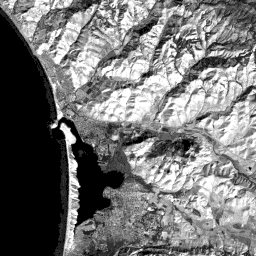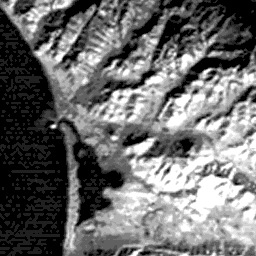 [an error occurred while processing this directive]
[an error occurred while processing this directive]
 [an error occurred while processing this directive]
[an error occurred while processing this directive]

 Now look at TM band 7 which is centered near 2.2 µm in the reflected
IR. The image has some similarities to both bands 1 and 4 but there are several obvious differences. All water is now completely
dark (no signs of reflecting sediments). Only faint traces of
the wave breakers remain. The beach sand is somewhat brighter
than in band 4. The sun-facing slopes in the hills seem to be
moderately brighter than in the other two bands. A bit more detail
emerges in the partially shadowed slopes. Some areas, such as
crop fields, that were quite bright in 4 are once again dark as
in 1. The mystery area around s shows some internal pattern or structure - including elongate
strips of lighter and darker - that affords a further clue to
its identity. The towns have a more diffuse street pattern and
are generally darker overall. The extraction pits so prominent
in band 1 are almost impossible to pick out in 7.
Now look at TM band 7 which is centered near 2.2 µm in the reflected
IR. The image has some similarities to both bands 1 and 4 but there are several obvious differences. All water is now completely
dark (no signs of reflecting sediments). Only faint traces of
the wave breakers remain. The beach sand is somewhat brighter
than in band 4. The sun-facing slopes in the hills seem to be
moderately brighter than in the other two bands. A bit more detail
emerges in the partially shadowed slopes. Some areas, such as
crop fields, that were quite bright in 4 are once again dark as
in 1. The mystery area around s shows some internal pattern or structure - including elongate
strips of lighter and darker - that affords a further clue to
its identity. The towns have a more diffuse street pattern and
are generally darker overall. The extraction pits so prominent
in band 1 are almost impossible to pick out in 7.
 Next, we will examine band 6 - the emitted thermal band (10.5-
12.5 µm). Remember that the spatial resolution for this band is
4 times coarser - 120 m compared with 30 m - than the other bands.
The effect of this reduced resolution is immediately evident in
viewing the subscene in that many details discernible in the other
bands tend to be "smeared" out in this one. Yet the main elements
you have come to know from bands already scanned are still readily
recognized.
Next, we will examine band 6 - the emitted thermal band (10.5-
12.5 µm). Remember that the spatial resolution for this band is
4 times coarser - 120 m compared with 30 m - than the other bands.
The effect of this reduced resolution is immediately evident in
viewing the subscene in that many details discernible in the other
bands tend to be "smeared" out in this one. Yet the main elements
you have come to know from bands already scanned are still readily
recognized.
In fact, the hilly terrain is even more like a 3-D rendition owing
to the sharp contrast between the hotter sun-facing slopes and
the back-facing slopes that are sufficiently cooler to appear
now as fairly uniform dark shadow-patterns. This gives a superior
sense of topographic relief to this part of the scene and also
brings out the valley regions. Some tones favoring medium gray,
as at v, represent the cooling effects of grass ground cover. An extremely
bright, but isolated, spot at h coincides with Morro Rock which, being a bare rock surface with
steep slopes, absorbs solar radiation and heats up so that it
becomes a significant emitter of thermal energy. The towns labeled
in yellow have moderate gray levels, indicating they are somewhat
cooler than the natural hillsides but several lighter tones within
them are located in the downtown areas which are customarily rather
warmer than residential areas (that have lawns and more trees).
Water, which has a notably higher heat capacity than most "dry"
materials found on land, nevertheless in daytime thermal IR images
tends to be cooler than most lighter land surfaces that are directly
heated. (Section 9, dealing with thermal imagery, reviews the
principles governing the tonal displays of features at different
radiant temperatures.) That is evident in this image in which
the ocean and the bay both have moderately dark gray levels. If
this image had been taken at night, the water would be expressed
in much lighter tones than the neighboring land because it has
retained much of its internal heat whereas the land has radiated
its absorbed solar energy thereby losing heat and cooling to radiant
temperatures lower than water. An uneven pattern of bands of slightly
lighter gray levels as seen in the Pacific Ocean is not "real"
here but is a noise-like artifact associated with the sensor response.
There is one pattern that is both anomalous and meaningful. In
the water just north and west of Morro Rock is an irregular pattern
with a lighter tone that jets out like a plume of sediment entering
the ocean from the shore. This is precisely what is expected from
the nearby power plant (at t) which dumps its thermally heated waste water into a nearby body
of standing water.

[an error occurred while processing this directive]

[an error occurred while processing this directive]

Code 935, Goddard Space Flight Center, NASA
Written by: Nicholas M. Short, Sr. email: nmshort@epix.net
and
Jon Robinson email: Jon.W.Robinson.1@gsfc.nasa.gov
Webmaster: Bill Dickinson Jr. email: rstwebmaster@gsti.com
Web Production: Christiane Robinson, Terri Ho and Nannette Fekete
Updated: 1999.03.15.
 Next, we will examine band 6 - the emitted thermal band (10.5-
12.5 µm). Remember that the spatial resolution for this band is
4 times coarser - 120 m compared with 30 m - than the other bands.
The effect of this reduced resolution is immediately evident in
viewing the subscene in that many details discernible in the other
bands tend to be "smeared" out in this one. Yet the main elements
you have come to know from bands already scanned are still readily
recognized.
Next, we will examine band 6 - the emitted thermal band (10.5-
12.5 µm). Remember that the spatial resolution for this band is
4 times coarser - 120 m compared with 30 m - than the other bands.
The effect of this reduced resolution is immediately evident in
viewing the subscene in that many details discernible in the other
bands tend to be "smeared" out in this one. Yet the main elements
you have come to know from bands already scanned are still readily
recognized. Now look at TM band 7 which is centered near 2.2 µm in the reflected
IR. The image has some similarities to both bands 1 and 4 but there are several obvious differences. All water is now completely
dark (no signs of reflecting sediments). Only faint traces of
the wave breakers remain. The beach sand is somewhat brighter
than in band 4. The sun-facing slopes in the hills seem to be
moderately brighter than in the other two bands. A bit more detail
emerges in the partially shadowed slopes. Some areas, such as
crop fields, that were quite bright in 4 are once again dark as
in 1. The mystery area around s shows some internal pattern or structure - including elongate
strips of lighter and darker - that affords a further clue to
its identity. The towns have a more diffuse street pattern and
are generally darker overall. The extraction pits so prominent
in band 1 are almost impossible to pick out in 7.
Now look at TM band 7 which is centered near 2.2 µm in the reflected
IR. The image has some similarities to both bands 1 and 4 but there are several obvious differences. All water is now completely
dark (no signs of reflecting sediments). Only faint traces of
the wave breakers remain. The beach sand is somewhat brighter
than in band 4. The sun-facing slopes in the hills seem to be
moderately brighter than in the other two bands. A bit more detail
emerges in the partially shadowed slopes. Some areas, such as
crop fields, that were quite bright in 4 are once again dark as
in 1. The mystery area around s shows some internal pattern or structure - including elongate
strips of lighter and darker - that affords a further clue to
its identity. The towns have a more diffuse street pattern and
are generally darker overall. The extraction pits so prominent
in band 1 are almost impossible to pick out in 7.